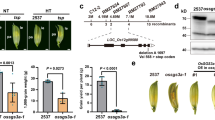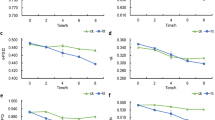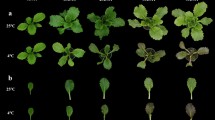Abstract
In the plant-beneficial, root-colonizing strain Pseudomonas fluorescens CHA0, the Gac/Rsm signal transduction pathway positively regulates the synthesis of biocontrol factors (mostly antifungal secondary metabolites) and contributes to oxidative stress response via the stress sigma factor RpoS. The backbone of this pathway consists of the GacS/GacA two-component system, which activates the expression of three small regulatory RNAs (RsmX, RsmY, RsmZ) and thereby counters translational repression exerted by the RsmA and RsmE proteins on target mRNAs encoding biocontrol factors. We found that the expression of typical biocontrol factors, that is, antibiotic compounds and hydrogen cyanide (involving the phlA and hcnA genes), was significantly lower at 35 °C than at 30 °C. The expression of the rpoS gene was affected in parallel. This temperature control depended on RetS, a sensor kinase acting as an antagonist of the GacS/GacA system. An additional sensor kinase, LadS, which activated the GacS/GacA system, apparently did not contribute to thermosensitivity. Mutations in gacS or gacA were epistatic to (that is, they overruled) mutations in retS or ladS for expression of the small RNAs RsmXYZ. These data are consistent with a model according to which RetS–GacS and LadS–GacS interactions shape the output of the Gac/Rsm pathway and the environmental temperature influences the RetS–GacS interaction in P. fluorescens CHA0.
Similar content being viewed by others
Log in or create a free account to read this content
Gain free access to this article, as well as selected content from this journal and more on nature.com
or
References
Aguilar PS, Hernandez-Arriaga AM, Cybulski LE, Erazo AC, de Mendoza D . (2001). Molecular basis of thermosensing: a two-component signal transduction thermometer in Bacillus subtilis. EMBO J 20: 1681–1691.
Bao Y, Lies DP, Fu H, Roberts GP . (1991). An improved Tn7-based system for the single-copy insertion of cloned genes into chromosomes of gram-negative bacteria. Gene 109: 167–168.
Baysse C, O’Gara F . (2007). Role of membrane structure during stress signalling and adaptation in Pseudomonas. In: Ramos JL, Filloux A (eds). Pseudomonas vol. 5. Springer: Heidelberg, Germany. pp 193–224.
Blumer C, Heeb S, Pessi G, Haas D . (1999). Global GacA-steered control of cyanide and exoprotease production in Pseudomonas fluorescens involves specific ribosome binding sites. Proc Natl Acad Sci USA 96: 14073–14078.
Braun Y, Smirnova AV, Schenk A, Weingart H, Burau C, Muskhelishvili G et al. (2008). Component and domain exchange analysis of a thermosensitive, two-component regulatory system of Pseudomonas syringae. Microbiology 154: 2700–2708.
Dubuis C, Haas D . (2007). Cross-species GacA-controlled induction of antibiosis in pseudomonads. Appl Environ Microbiol 73: 650–654.
Dubuis C, Keel C, Haas D . (2007). Dialogues of root-colonizing biocontrol pseudomonads. Eur J Plant Pathol 119: 311–328.
Farinha MA, Kropinsky AM . (1990). High efficiency electroporation of Pseudomonas aeruginosa using frozen cell suspensions. FEMS Microbiol Lett 58: 221–225.
Gamper M, Ganter B, Polito MR, Haas D . (1992). RNA processing modulates the expression of the arcDABC operon in Pseudomonas aeruginosa. J Mol Biol 226: 943–957.
Gooderham JW, Hancock REW . (2009). Regulation of virulence and antibiotic resistance by two-component regulatory systems in Pseudomonas aeruginosa. FEMS Microbiol Rev 33: 279–294.
Goodman AL, Kulasekara B, Rietsch A, Boyd D, Smith RS, Lory S . (2004). A signaling network reciprocally regulates genes associated with acute infection and chronic persistence in Pseudomonas aeruginosa. Dev Cell 7: 745–754.
Goodman AL, Merighi M, Hyodo M, Ventre I, Filloux A, Lory S . (2009). Direct interaction between sensor kinase proteins mediates acute and chronic disease phenotypes in a bacterial pathogen. Genes Dev 23: 249–259.
Haas D, Défago G . (2005). Biological control of soil-borne pathogens by fluorescent pseudomonads. Nat Rev Microbiol 3: 307–319.
Haas D, Keel C . (2003). Regulation of antibiotic production in root-colonizing Pseudomonas spp. and relevance for biological control of plant disease. Annu Rev Phytopathol 41: 117–153.
Hazelbauer GL, Falke JJ, Parkinson JS . (2008). Bacterial chemoreceptors: high-performance signaling in networked arrays. Trends Biochem Sci 33: 9–19.
Heeb S, Blumer C, Haas D . (2002). Regulatory RNA as mediator in GacA/RsmA-dependent global control of exoproduct formation in Pseudomonas fluorescens CHA0. J Bacteriol 184: 1046–1056.
Heeb S, Haas D . (2001). Regulatory roles of the GacS/GacA two-component system in plant-associated and other gram-negative bacteria. Mol Plant Microbe Interact 14: 1351–1363.
Heeb S, Valverde C, Gigot-Bonnefoy C, Haas D . (2005). Role of the stress sigma factor RpoS in GacA/RsmA-controlled secondary metabolism and resistance to oxidative stress in Pseudomonas fluorescens CHA0. FEMS Microbiol Lett 243: 251–258.
Hunger K, Beckering CL, Marahiel MA . (2004). Genetic evidence for the temperature-sensing ability of the membrane domain of the Bacillus subtilis histidine kinase DesK. FEMS Microbiol Lett 230: 41–46.
Kay E, Dubuis C, Haas D . (2005). Three small RNAs jointly ensure secondary metabolism and biocontrol in Pseudomonas fluorescens CHA0. Proc Natl Acad Sci USA 102: 17136–17141.
Kay E, Humair B, Dénervaud V, Riedel K, Spahr S, Eberl L et al. (2006). Two GacA-dependent small RNAs modulate the quorum sensing response in Pseudomonas aeruginosa. J Bacteriol 188: 6026–6033.
Lapouge K, Schubert M, Allain FHT, Haas D . (2008). Gac/Rsm signal transduction pathway of γ-proteobacteria: from RNA recognition to regulation of social behaviour. Mol Microbiol 67: 241–253.
Lapouge K, Sineva E, Lindell M, Starke K, Baker CS, Babitzke P et al. (2007). Mechanism of hcnA mRNA recognition in the Gac/Rsm signal transduction pathway of Pseudomonas fluorescens. Mol Microbiol 66: 341–356.
Laskowski MA, Kazmierczak BI . (2006). Mutational analysis of RetS, an unusual sensor kinase-response regulator hybrid required for Pseudomonas aeruginosa virulence. Infect Immun 74: 4462–4473.
Laville J, Voisard C, Keel C, Maurhofer M, Défago G, Haas D . (1992). Global control in Pseudomonas fluorescens mediating antibiotic synthesis and suppression of black root rot of tobacco. Proc Natl Acad Sci USA 89: 1562–1566.
Loper JE, Kobayashi DY, Paulsen IT . (2007). The genomic sequence of Pseudomonas fluorescens Pf-5: insights into biological control. Phytopathology 97: 233–238.
Mark GL, Morrissey JP, Higgins P, O’Gara F . (2006). Molecular-based strategies to exploit Pseudomonas biocontrol strains for environmental biotechnology applications. FEMS Microbiol Ecol 56: 167–177.
Mercado-Blanco J, Bakker PAHM . (2007). Interactions between plants and beneficial Pseudomonas spp.: exploiting bacterial traits for crop protection. Antonie van Leeuwenhoek 92: 367–389.
Miller JH . (1972). Experiments in Molecular Genetics. Cold Spring Harbor Laboratory Press: Cold Spring Harbor, NY.
Mondragón V, Franco B, Jonas K, Suzuki K, Romeo T, Melefors O et al. (2006). pH-dependent activation of the BarA-UvrY two-component system in Escherichia coli. J Bacteriol 188: 8303–8306.
Palmer DA, Bender CL . (1993). Effects of environmental and nutritional factors on production of the polyketide phytotoxin coronatine by Pseudomonas syringae pv. glycinea. Appl Environ Microbiol 59: 1619–1626.
Paulsen IT, Press CM, Ravel J, Kobayashi DY, Myers GS, Mavrodi DV et al. (2005). Complete genome sequence of the plant commensal Pseudomonas fluorescens Pf-5. Nat Biotechnol 23: 873–878.
Reimmann C, Valverde C, Kay E, Haas D . (2005). Posttranscriptional repression of GacS/GacA-controlled genes by the RNA-binding protein RsmE acting together with RsmA in the biocontrol strain Pseudomonas fluorescens CHA0. J Bacteriol 187: 276–285.
Rich JJ, Kinscherf TG, Kitten T, Willis DK . (1994). Genetic evidence that the gacA gene encodes the cognate response regulator for the lemA sensor in Pseudomonas syringae. J Bacteriol 176: 7468–7475.
Sambrook J, Russell DW . (2001). Molecular Cloning: A Laboratory Manual, 3rd edn. Cold Spring Harbor Laboratory Press: Cold Spring Harbor, NY.
Schmidt CS, Agostini F, Leifert C, Killham K, Mullins CE . (2004). Influence of soil temperature and matric potential on sugar beet seedling colonization and suppression of Pythium damping-off by the antagonistic bacteria Pseudomonas fluorescens and Bacillus subtilis. Phytopathology 94: 351–363.
Schnider-Keel U, Seematter A, Maurhofer M, Blumer C, Duffy B, Gigot-Bonnefoy C et al. (2000). Autoinduction of 2,4-diacetylphloroglucinol biosynthesis in the biocontrol agent Pseudomonas fluorescens CHA0 and repression by the bacterial metabolites salicylate and pyoluteorin. J Bacteriol 182: 1215–1225.
Shanahan P, O′Sullivan DJ, Simpson P, Glennon JD, O’Gara F . (1992). Isolation of 2,4-diacetylphloroglucinol from a fluorescent pseudomonad and investigation of physiological parameters influencing its production. Appl Environ Microbiol 58: 353–358.
Slininger PJ, Shea-Wilbur MA . (1995). Liquid-culture pH, temperature, and carbon (not nitrogen) source regulate phenazine productivity of the take-all biocontrol agent Pseudomonas fluorescens 2-79. Appl Microbiol Biotechnol 43: 794–800.
Stanisich VA, Holloway BW . (1972). A mutant sex factor of Pseudomonas aeruginosa. Genet Res 19: 91–108.
Valverde C, Heeb S, Keel C, Haas D . (2003). RsmY, a small regulatory RNA, is required in concert with RsmZ for GacA-dependent expression of biocontrol traits in Pseudomonas fluorescens CHA0. Mol Microbiol 50: 1361–1379.
Valverde C, Lindell M, Wagner EG, Haas D . (2004). A repeated GGA motif is critical for the activity and stability of the riboregulator RsmY of Pseudomonas fluorescens. J Biol Chem 279: 25066–25074.
Ventre I, Goodman AL, Valley-Gely I, Vasseur P, Soscia C, Molin S et al. (2006). Multiple sensors control reciprocal expression of Pseudomonas aeruginosa regulatory RNA and virulence genes. Proc Natl Acad Sci USA 103: 171–176.
Vieira J, Messing J . (1991). New pUC-derived cloning vectors with different selectable markers and DNA replication origins. Gene 100: 189–194.
Voisard C, Bull CT, Keel C, Laville J, Maurhofer M, Schnider U et al. (1994). Biocontrol of root diseases by Pseudomonas fluorescens CHA0: current concepts and experimental approaches. In: O’Gara F, Dowling DN, Boesten B (eds). Molecular Ecology of Rhizosphere Microorganisms. VCH: Weinheim, Germany. pp 67–89.
Workentine ML, Chang L, Ceri H, Turner RJ . (2009). The GacS-GacA two-component regulatory system of Pseudomonas fluorescens: a bacterial two-hybrid analysis. FEMS Microbiol Lett 292: 50–56.
Zuber S, Carruthers F, Keel C, Mattart A, Blumer C, Pessi G et al. (2003). GacS sensor domains pertinent to the regulation of exoproduct formation and to the biocontrol potential of Pseudomonas fluorescens CHA0. Mol Plant Microbe Interact 16: 634–644.
Acknowledgements
This work was supported by the Swiss National Foundation (project 3100A0-100180) and, in part, by a genomics project of the University of Lausanne.
Author information
Authors and Affiliations
Corresponding author
Additional information
Supplementary Information accompanies the paper on The ISME Journal website (http://www.nature.com/ismej)
Rights and permissions
About this article
Cite this article
Humair, B., González, N., Mossialos, D. et al. Temperature-responsive sensing regulates biocontrol factor expression in Pseudomonas fluorescens CHA0. ISME J 3, 955–965 (2009). https://doi.org/10.1038/ismej.2009.42
Received:
Revised:
Accepted:
Published:
Issue date:
DOI: https://doi.org/10.1038/ismej.2009.42
Keywords
This article is cited by
-
Insights into the temperature responses of Pseudomonas species in beneficial and pathogenic host interactions
Applied Microbiology and Biotechnology (2022)
-
Variation in Metabolite Profiles of Amphibian Skin Bacterial Communities Across Elevations in the Neotropics
Microbial Ecology (2017)
-
RsmW, Pseudomonas aeruginosa small non-coding RsmA-binding RNA upregulated in biofilm versus planktonic growth conditions
BMC Microbiology (2016)
-
Regulation of gene expression in Pseudomonas aeruginosa M18 by phenazine-1-carboxylic acid
Applied Microbiology and Biotechnology (2015)
-
Small RNAs as regulators of primary and secondary metabolism in Pseudomonas species
Applied Microbiology and Biotechnology (2011)



